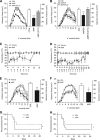AMP-dependent hypothermia affords protection from ischemic brain injury
- PMID: 23211965
- PMCID: PMC3564206
- DOI: 10.1038/jcbfm.2012.181
AMP-dependent hypothermia affords protection from ischemic brain injury
Abstract
In light of the relevance of therapeutic hypothermia to stroke treatment, we investigated whether 5'-adenosine monophosphate (AMP)-dependent cooling affords protection from ischemic brain injury. We show that hypothermia by AMP is because of adenosine A1 receptor (A1R) activation and is not invariantly associated with hypotension. Inhibition of ecto-5'-nucleotidase-dependent constitutive degradation of brain extracellular AMP by methylene-ADP (AMPCP) also suffices to prompt A1R-dependent hypothermia without hypotension. Both intraischemic and postischemic hypothermia by AMP or AMPCP reduce infarct volumes and mortality of mice subjected to transient middle cerebral artery occlusion. Data disclose that AMP-dependent hypothermia is of therapeutic relevance to treatment of brain ischemia.
Figures


References
-
- Shah PS. Hypothermia: a systematic review and meta-analysis of clinical trials. Semin Fetal Neonatal Med. 2010;15:238–246. - PubMed
-
- Yenari MA, Han HS. Neuroprotective mechanisms of hypothermia in brain ischaemia. Nat Rev Neurosci. 2012;13:267–278. - PubMed
-
- Diller KR, Zhu L. Hypothermia therapy for brain injury. Annu Rev Biomed Eng. 2009;11:135–162. - PubMed
Publication types
MeSH terms
Substances
LinkOut - more resources
Full Text Sources
Research Materials

